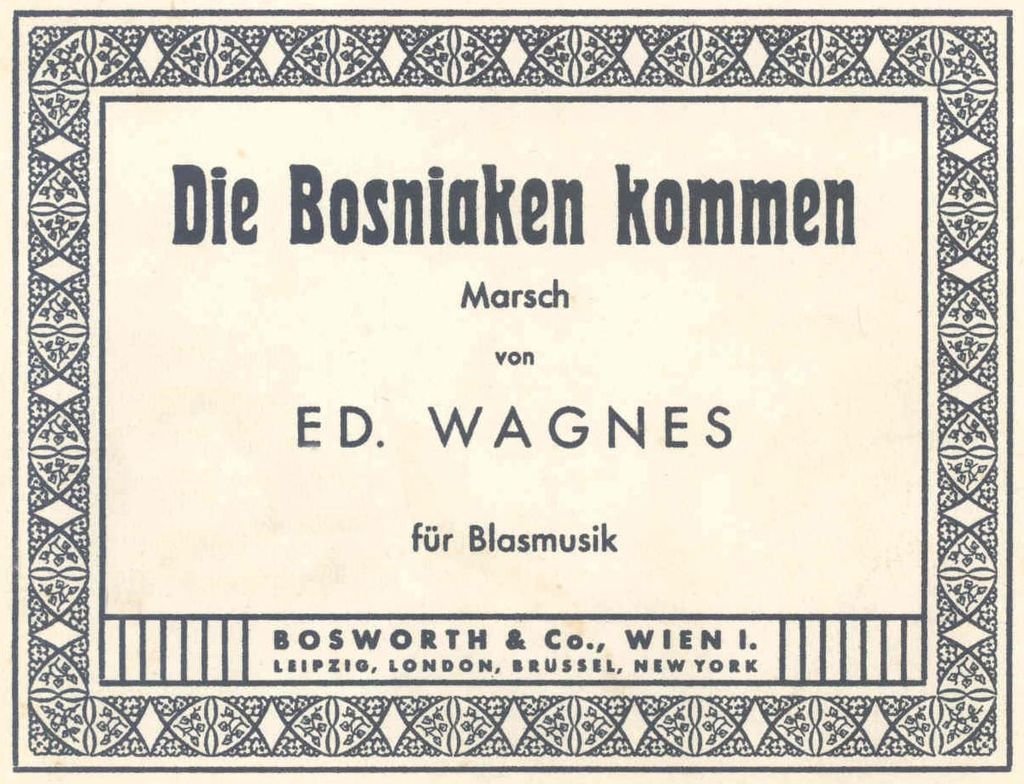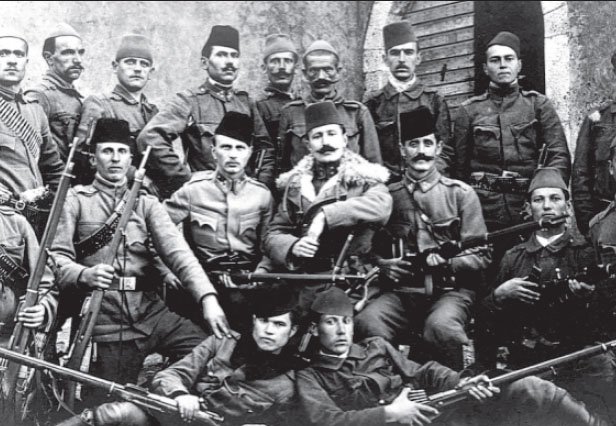
BOSNIAKS ARE COMING
Author: Prof. Aida Abadžić Hodžić, PhD, Faculty of Philosophy of University of Sarajevo • Illustration: Austrian composer Eduard Wagnes' military march in honor of Bosniak soldiers, 1895.

Soon upon the establishment of Austro-Hungarian administration in Bosnia, as early as in 1881, general conscription was introduced which pertained to all 20-year-old boys and which lasted for three years: first on the front lines and over the following nine years in the obligatory army reserves. During the First World War, Bosniak regiments participated at various battlefields, and they gave a decisive contribution on the so-called Soča Front (or Isonzo Front), which was 600 kilometer long and positioned in the tri-border area between of Austria, Slovenia and Italy. Bosniaks were main participants in the biggest and longest mountain battle in history, which was led in extreme conditions, since it continuously lasted for 29 months (from May 1915 to November 1917), on the elevations over 2,000-meter altitude, with bunkers of ice and iron stairs hammered in stone which Bosniak soldiers had to climb in full battle gear, and where over a million and 200 thousand soldiers were killed! From four regiments from Bosnia and Herzegovina which fought in the First World War, the best soldiers were selected and under the name of the Fourth BH Regiment deployed on the Western Front, in the rank of the prime royal and imperial formation (Schachinger, 1989, 11). According to data of the time, during the First World War troops from Bosnia and Herzegovina which were part of Austro-Hungarian army numbered over 250,000 people.
At the time, Bosniak units referred to all soldiers who were from Bosnia regardless of their religion. Within the Austro-Hungarian army, Bosniak soldiers stood out by distinctive blue uniforms with čakšire (woolen trousers baggy do the knees and tight under the knees) and fezzes (grey and red) and by using knives and maces. However, what particularly distinguished Bosniaks was extreme courage and fearlessness, which have been confirmed by many testimonies and archival documents which can mainly be found in the Museum of Soča Front at Kobarid and in Garnisonsmuseum in Graz. No regiment of Austro-Hungarian army received more ordains and honors for the contribution and courage than the Bosniak regiment (Kubinzky, 2010, 15). Curator of the museum at Kobarid Vojo Hibič points out:
“Italians had only to see soldiers with fezzes, and they began to flee. It was exploited by the command of Austro-Hungarian army, who make soldiers of other nations put on the traditional Bosniak cap. It remained recorded that, when there were no enough Bosniaks, people carried fezzes on stick through trenches, so that Italians could guess who was waiting for them on the other side. At the same time, the preserved documents describe Bosniaks as people with the kindest hearts as well. They shared their last piece of bread. It was them who rescued most wounded from the battlefield. Slovenians and Austrians did not dare leave the trench after the battle, but Bosniaks expressed their courage in this way as well, taking the wounded and carrying them to field hospitals …ˮ (Schachinger, 1989, 13).
And when, after eleven Italian offensives, Bosniaks were replaced by equally famous “Salzburg forest hunters”, even then, according to the director of the Museum of Soča Front, “muezzins were left there whose calls to prayer let Italians know that Bosniaks were somewhere around” (Schachinger, 1989, 14). In the village of Log pod Mangartom, in the background of the highest elevation point (2.208 m.a.s.l.) the first mosque in Slovenia was built in 1916.
Almost five thousand Bosniaks lost their lives in Slovenia during the First World War. A total of 102 Bosniak soldiers are buried at the military cemetery Log pod Mangartom. Thanks to efforts by Slovenian mufti of the time, Nedžad Grabus, PhD, and the support of the state of Slovenia, crosses which were placed on the tombs of Bosniaks during the Kingdom of Serbs, Croats and Slovenes were replaced by nišans (Islamic tombstones) in 2007, and in 2012 a memorial for killed soldiers from BiH was erected, a work by Slovenian sculptor of Bosnian and Herzegovinian origin Mirsad Begić.
About eight hundred Bosniak soldiers who were members of the former 19th infantry regiment of the Austro-Hungarian army were buried at the Military Cemetery Lang-Lebring near Graz. Every year, on the last Sunday in October, the so-called Bosniak Sunday (Bosniakensonntag) is marked, in the memory of all the killed soldiers of Austro-Hungarian Army in the First World War, of all religions. Until 1914, members of the Bosniak regiment were stationed in the Dominican barracks in Graz, where there was an Oriental café, and for the needs of Muslim soldiers, the service of military imam was provided (Kubinzky, 2010, 15).
In the honor of infantry regiments from Bosnia and Herzegovina which were part of Austro-Hungarian army, and their extreme bravery, Austrian composer Eduard Wagnes composed, in Graz in 1895, a military march entitled “Bosniaks are coming” (Die Bosniaken kommen). It is one of the most popular military marches which is still performed on special occasions, and it is the traditional march of the 1st battalion of Austrian army.
References:
Prof. Karl-Albrecht Kubinzky, PhD, “1895: Die Bosniaken kommenˮ, BIG (Bürger:inneninformation), Graz, 2010, 14-15.
Werner Schachinger,Die Bosniaken kommen, Elitetruppe in der k.und k. Armee 1879-1918, Graz-Stuttgart, 1989 (translated from German into Croatian by O. Mujkanović, Lovran,








